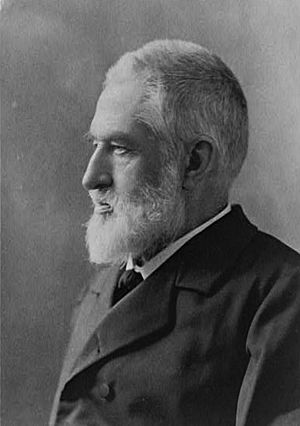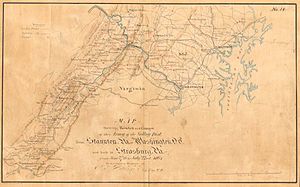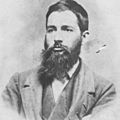Jedediah Hotchkiss facts for kids
Jedediah Hotchkiss (born November 30, 1828 – died January 17, 1899) was a talented teacher and the most famous mapmaker of the American Civil War. Many people believe his detailed and accurate maps of the Shenandoah Valley were a key reason for Confederate General Stonewall Jackson's victories in the Valley Campaign of 1862.
Contents
Early Life and Education
Jedediah Hotchkiss was born in Windsor, New York. He finished school at the Windsor Academy. By the time he was 18, he was already teaching school himself in Lykens Valley, Pennsylvania. The next year, he moved to the beautiful Shenandoah Valley in Virginia. There, he opened his own school called the Mossy Creek Academy in Augusta County.
To earn more money, he also worked as a geologist, studying rocks and minerals. As he explored the area, he started his hobby of making maps. This hobby soon became a small business and would become very important later in his life. In 1853, he married Sara Ann Comfort from Pennsylvania, and they had two daughters. In 1855, Jedediah and his brother Nelson started another school for boys called the Loch Willow Academy in Churchville, Virginia. His childhood home, the Jedediah Hotchkiss House, is now a historic landmark.
Mapping During the Civil War
In June 1861, Hotchkiss joined the Confederate army as a teamster, helping to transport supplies. He soon offered his skills as a mapmaker to General Richard B. Garnett. Hotchkiss made maps for General Robert E. Lee's plans in the mountains. After a short break due to illness, he returned to duty in March 1862. He became the main map engineer for the Valley District, working for General Stonewall Jackson.
After a battle, on March 26, 1862, General Jackson asked Hotchkiss for a very important map. Jackson told him, "Make me a map of the Shenandoah Valley, from Harper's Ferry to Lexington, showing all the points of offense and defense." Hotchkiss immediately suggested that Jackson move his troops to Rude's Hill, a better defensive spot. Jackson followed this advice and reorganized his army there, which helped him win many battles in the 1862 Valley Campaign.
The Shenandoah Valley had never been mapped in such detail before. It was a huge area, about 150 miles long and 25 miles wide. Hotchkiss accepted the challenge and worked on this map for the rest of the war. To make it, he glued together three pieces of tracing cloth, creating one large map that was 7 feet long and 3 feet wide!
Captain Hotchkiss stayed with General Jackson for the rest of Jackson's life. He created many accurate and detailed maps. He also helped Jackson by guiding troop movements across the land he knew so well. Jackson was known for his fast movements and surprise attacks, which often confused his enemies. Hotchkiss's amazing maps played a big part in this success.
They worked together in many important campaigns, including the Valley Campaign, the Northern Virginia Campaign (which included battles like Second Battle of Bull Run), and the Maryland Campaign (including Antietam). At the Battle of Chancellorsville in May 1863, Jackson asked Hotchkiss for maps of the area. Hotchkiss, with help from local people, found the secret path Jackson's army took to surprise the Union Army. That night, Jackson was badly wounded and died less than two weeks later.
After Jackson's death, Hotchkiss continued to work for other Confederate generals, like Richard S. Ewell and Jubal Early. He was also often called to work directly for General Robert E. Lee. He served through the Gettysburg Campaign and other major battles. In June 1864, he went with General Early on a raid through the Shenandoah Valley towards Washington, D.C.. One of his maps helped Early launch a surprise attack at the Battle of Cedar Creek. Hotchkiss then returned to the Siege of Petersburg and stayed there until the war ended.
After General Lee surrendered in April 1865, Hotchkiss surrendered to the Union Army. General Ulysses S. Grant allowed Hotchkiss to be released and even returned his maps to him. Grant paid Hotchkiss to use some of his maps for his own reports. Almost all of the Confederate maps in the official war records were drawn by Hotchkiss.
Life After the War
After the war, Hotchkiss returned to Staunton, Virginia. He reopened his school and worked to help the Shenandoah Valley recover from the war. He also helped with veterans' affairs. Besides teaching, he opened an office as an engineer, focusing on civil and mining projects. Because he knew the geography of Virginia so well, he was able to guide foreign and Northern investors to the best places for new businesses.
In October 1865, a government detective tried to take Hotchkiss's map collection. Hotchkiss refused and managed to keep all his maps. He even prepared maps of Virginia counties for the United States Army.
Hotchkiss helped write a 12-volume book series called Confederate Military History. He wrote the entire 1,295-page volume about Virginia himself. His personal journals were published in 1973 as Make Me a Map of the Valley: The Civil War Journal of Stonewall Jackson's Cartographer. Hotchkiss's sketchbooks, diaries, and maps are now kept at the Library of Congress in Washington, D.C..
Jedediah Hotchkiss passed away at his home in Staunton at age 71. He is buried in Thornrose Cemetery there. A small town in Raleigh County, called Hotchkiss, West Virginia, was named after him. The beautiful mansion he built in 1888 in Staunton, Virginia, still stands today. It is known as The Oaks and is listed on the National Register of Historic Places.
The Hotchkiss Map Collection
The Hotchkiss collection has over 600 maps, mostly about Virginia and West Virginia from 1861 to 1865. Some maps are from his work after the war, some are of specific properties, and some were made by others. His family kept the map collection after his death and after he refused the government's order to take them.
In 1948, the maps were finally given to the Library of Congress, which then published them in 1951. Three of the original maps were given by the Hotchkiss family to the Handley Library in Winchester, Virginia. These include a map of the Gettysburg Campaign and two battle sketches of Winchester. The Jedediah Hotchkiss Papers, which include his maps and writings, are available at the Handley Regional Library in Winchester, Virginia.
Images for kids




